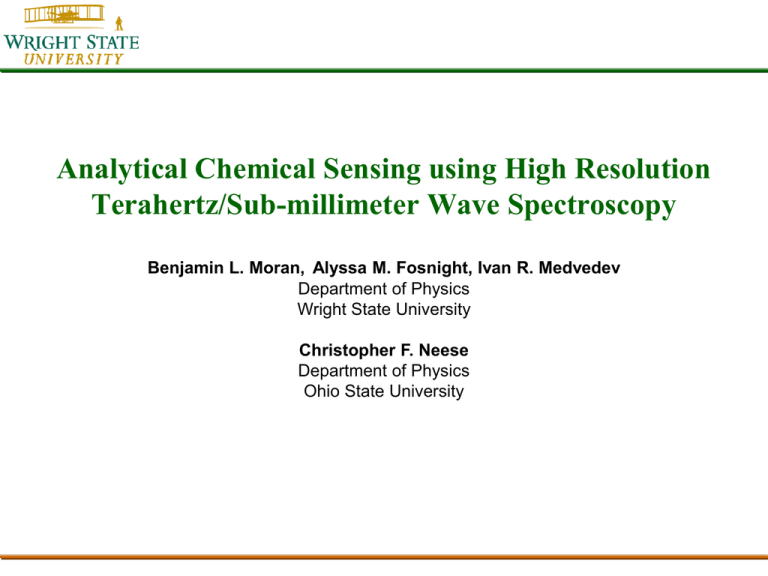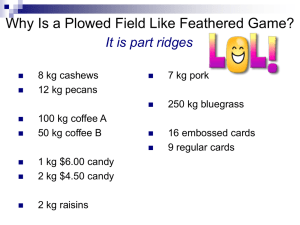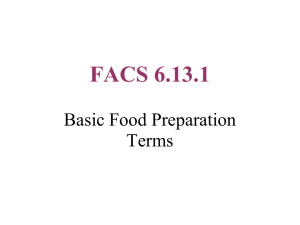columbus spec
advertisement

Analytical Chemical Sensing using High Resolution Terahertz/Sub-millimeter Wave Spectroscopy Benjamin L. Moran, Alyssa M. Fosnight, Ivan R. Medvedev Department of Physics Wright State University Christopher F. Neese Department of Physics Ohio State University The Experiment • • A THz gas phase chemical sensor was created which is capable of analyzing complex atmospheric mixtures of volatile organic compounds(VOC’s). A chemical preconcentrator was coupled to a custom THz spectrometer. Using this sensor we can analyze complex mixtures. This experiment is a proof of principle for the long term goal of analyzing environmental gas mixtures and exhaled human breath. The System Continuous Wave THz Spectrometer Additional Details Microwave Synthesizer Custom Built VDI Diode Multipliers Virginia Diodes (210-270 GHz) Preconcentrator Entech 7100A Absorption Cell 2m long by 4” wide (14L) Scientific Advantages of Rotational Spectroscopy for Chemical Detection • Advantages for Chemical Detection – Spectral signature is extremely sensitive to conformational and isotopic changes of molecular structure. – Energy level separations are much less than kT, resulting in a large number of thermally populated energy levels. – Applicable to polar neutral and reactive species. – High Accuracy of the Measured Frequency of Molecular Transitions. – High Number of Resolution Elements (Determined by Doppler limited line width) for Analysis of Complex Mixtures. – Total amount of sample needed for detection is small. • Samples are generally static. – Highly-Sensitive Spectrometer Design. – Detection based on spectroscopic signatures requires no calibration. Related Work: Mission Adaptable Chemical Sensor Developed at Ohio State University • Project Goals: – Entire sensor must fit inside a 1 CF box including: • Vacuum system capable of providing 10-5 atm ideal sample pressure • Preconcentrator for removing atmospheric gases • X-band synthesizer • SMM TX/RX and Folded Absorption Cell • Data acquisition hardware • Computer for data analysis • Power and conditioning – No consumables (cryogens / carrier gases) – Sensitivity goal of < 100 ppt for one analyte • Tests preconcentrator and spectrometer – Selectivity goal of analyzing mixtures from a library of >31 analytes • Test for spectrometer only. IEEE SENSORS JOURNAL, VOL. 12, NO. 8, AUGUST 2012 2565 Compact Submillimeter/Terahertz Gas Sensor With Efficient Gas Collection, Preconcentration, and ppt Sensitivity Christopher F. Neese, Ivan R. Medvedev, Grant M. Plummer, Aaron J. Frank,Christopher D. Ball, and Frank C. De Lucia, Member, IEEE 66th International Symposium on Molecular Spectroscopy in 2011 A SUBMILLIMETER CHEMICAL SENSOR CHRISTOPHER F. NEESE, IVAN R. MEDVEDEV, FRANK C. DE LUCIA, Department of Physics, 191 W. Woodruff Ave., Ohio State University, Columbus, OH 43210 USA; GRANT M. PLUMMER, Enthalpy Analytical, Inc., 2202 Ellis Rd., Durham, NC 27703 USA; CHRISTOPHER D. BALL, AARON J. FRANK, Battelle Memorial Institute, 505 King Ave., Columbus, OH 43201 USA. Chemical Selection • • • • Method TO-14A certified mixture sold by Scott Specialty Gases Selection Process: – Only polar molecules exhibit rotational spectra. – Two ab-initio software programs, GAMESS and Gaussian, were used to calculate electric dipole moments and molecular structures. 26 of the 39 chemicals were identified to be suitable for THz spectroscopic detection. 19 of the 26 are on the Clean air Act of 1990 as hazardous air pollutants TO-14A Mixture(≈1 ppm each) *Benzene *Bromomethane *Carbon Tetrachloride *Chlorobenzene *Chloroethane *Chloroform *Chloromethane 1,2 Dibromoethane *Methylene Chloride *1,2,4 Trichlorobenzene 1,2,4 Trimethylbenzene *Toluene *m-Xylene *Cis 1,3 Dichloropropene Cis-1,2 Dichloroethene *Ethylbenzene *Freon 11 *Freon 12 *Freon 113 *Freon 114 1,2 Dichlorobenzene 1,3 Dichlorobenzene 1,4 Dichlorobenzene *1,1 Dichloroethane 1,2 Dichloroethane 1,1 Dichloroethene *1,2 Dichloropropane *Styrene 1,1,1 Trichloroethane 1,3,5 Trimethylbenzene *Trichloroethylene *o-Xylene *Hexachloro-1,3 Butadiene *1,1,2,2 Tertachloroethane *1,1,2 Trichloroethane *Tetrachloroethene *Vinyl Chloride *p-Xylene 1,2,4 Trimethylbenzene *Trans 1,3 Dichloropropene Analytical Chemical Detection Algorithm 1. Create the spectral libraries • • • Collect spectra of the pure samples at a well defined pressures (1 mTorr, 2mTorr, 5mTorr) Select several strongest lines within the library spectrum to use as markers for mixture analysis (snippets) Made a total snippet library 2. Record spectra of the analytes in the mixture • • • • Fill a Tedlar bag with 1 ppm mixture of VOC’s Use preconcentrator to remove major air constituents (O2, N2, H2O, Ar, CO2) Inject preconcentrator mixture into the absorption cell Record the snippet spectra 3. Perform spectral analysis • • Calculate partial pressures of every analyte present in the absorption cell by performing the Least Squares Fitting of the mixture spectrum to the library spectra. Deduce the dilution of each analyte in the original mixture based on the volume of the absorption cell and preconcentration efficiency of our preconcentrator Overview Library Spectra • • All chemicals were placed into flasks and were frozen using liquid nitrogen in an attempt to ensure their chemical purity. Each flask was separately connected to the vacuum port and an overview library spectrum was taken from 210 to 270 GHz at a pressure of 1 mTorr. 1.0 0.5 0.0 -0.5 290 210 300 225 310 240 GHz GHz Overview Spectrum of Chloroethane 320 255 330 270 Intensity Linearity • • Recorded spectra for a range of sample pressures. Linearity was checked to ensure that the chosen spectral lines belong to the chemical of choice, as well as to select a proper pressure range. Snippets • • • A snippet is a scan around a single line in the spectrum. For each chemical 5 to 7 lines were selected from within the overview spectrum of each chemical, which showed no spectral overlaps with other chemicals. Snippets for all 26 chemicals were combined and rescanned for each chemical to catalog any possible spectral overlaps between chemicals. 210 255 Preconcentrator ENTECH 7100A Preconcentrator Dual Stage Cryo-Sorbent Device • Removes major atmospheric constituents CO2, H2O, N2, O2, and Ar. • Increases our sensitivity and specificity • Certified to have high efficiency for TO-14A Mixture. • Microscale Purge and Trap Sampling Method • Trap 1: Glass Beads • Trap 2: Glass Beads/Tenax http://www.entechinst.com/ Least Squares Fitting Routine • • • • Using Wavematric’s Igor Pro we developed a fitting routine to fit for the baseline and normalized for the gains. Each chemical has 220 linear baseline fits (440 parameters). Then using the libraries we fit the signals intensity(26 parameters). Results in 466 fit parameters for entire mixture. Mixture 4500cc Sampled RED=Mixture BLACK=Least Squares Fit Blue=Residuals Determining Partial Pressure of the Analyte • Libraries were collected at 1mTorr • Least squares returns partial pressure of an analyte in the mixture in mTorr Result of Least Squares Fit Partial Pressure of sample in Tedlar bag 𝑃𝑎𝑟𝑡𝑖𝑎𝑙 𝑃𝑟𝑒𝑠𝑠𝑢𝑟𝑒 𝑖𝑛 𝐶𝑒𝑙𝑙 = (𝑝𝑝𝑚)(10−6 ) Dilution of an analyte in mixture 760 𝑇𝑜𝑟𝑟 1 𝑎𝑡𝑚 Volumetric Dilution 4.5𝐿 (𝑝) 14𝐿 Preconcentration Efficiency Results(Glass Beads, Glass Beads) Chemical Chloromethane Bromomethane Vinyl Chloride Chloroethane Methylene Chloride cis-1,2-Dichloroethene 1,1-Dichloroethane 1,1,1 Trichloroethane Chloroform Chlorobenzene Freon 12 1,2 Dichloroethane Trichloroethylene 1,2 Dichlorobenzene 1,1 Dichloroethene Freon 11 1,2 Dibromoethane 1,1,2,2Tetrachloroethane S2 S3 S4 S5 S6 S7 S8 S9 S10 S11 S12 S13 S14 S15 S16 S17 S19 S25 Least Squares partial pressure (mTorr) Expected Partial Pressure (mTorr) Preconcentration Efficiency 0.326 0.271 0.225 0.197 0.177 0.173 0.178 0.180 0.067 0.013 0.23 0.156 0.246 0.027 0.173 0.193 0.221 0.333 0.254 0.232 0.244 0.237 0.235 0.249 0.244 0.244 0.247 0.244 0.249 0.251 0.251 0.251 0.244 0.244 0.252 0.254 127% 116% 92% 83% 75% 69% 73% 74% 27% 5% 94% 62% 98% 12% 71% 77% 88% 133% Results: Preconcentration is 100% Efficient (Glass Beads, Glass Beads) Dilution if 100% Preconcentration Efficiency(ppm) Expected Dilution (ppm) Chemical Chloromethane Bromomethane Vinyl Chloride Chloroethane Methylene Chloride cis-1,2-Dichloroethene 1,1-Dichloroethane 1,1,1 Trichloroethane Chloroform Chlorobenzene Freon 12 1,2 Dichloroethane Trichloroethylene 1,2 Dichlorobenzene 1,1 Dichloroethene Freon 11 1,2 Dibromoethane 1,1,2,2Tetrachloroethane S2 S3 S4 S5 S6 S7 S8 S9 S10 S11 S12 S13 S14 S15 S16 S17 S19 S25 1.33 1.107 0.919 0.807 0.723 0.708 0.728 0.738 0.272 0.052 0.935 0.638 1.01 0.122 0.708 0.790 0.905 1.362 1.04 0.95 1.00 0.97 0.96 1.02 1.00 1.00 1.01 1.00 1.02 1.03 1.03 1.03 1.00 1.03 1.03 1.02 Percentage Recovery if preconcentration is 100% 127% 116% 92% 83% 75% 69% 73% 74% 27% 5% 94% 62% 98% 12% 71% 77% 88% 133% Results(1000cc): Glass Beads,Tenax Chemical Dilution if 100% Preconcentration Efficiency(ppm) Expected Dilution (ppm) Percentage Recovery if preconcentration is 100% Chloromethane S2 1.09 1.1 98% Bromomethane S3 0.461 0.91 51% Vinyl Chloride S4 0.781 1.04 75% Chloroethane S5 0.561 0.98 57% Methylene Chloride S6 0.554 1.05 53% cis-1,2-Dichloroethene S7 0.545 1.05 53% 1,1-Dichloroethane S8 0.684 1.05 65% 1,1,1 Trichloroethane S9 0.512 1.06 48% Chloroform S10 0.444 1.04 43% Chlorobenzene S11 0.608 1.05 58% Freon 12 S12 0.824 1.05 79% 1,2 Dichloroethane S13 0.579 1.04 55% 1,1 Dichloroethene S15 0.503 1.05 47% Conclusions • Through this research we have demonstrated a THz sensor capable of analytical chemical sensing for environmental purposes. • The preconcentrator efficiency is generally above 60% • Sensor can be made more compact. • Opens possibilities using other chemicals and applications – Exhaled Breath Analysis Path Forward: Exhaled Breath analysis VOC Isoprene Mercaptans Dimethyl sulfide Methanethiol Ammonia Amines Methylamine Acetone Methanol Ethanol 2-propanol Acetaldehyde OCS NO, CO Toluene Ethylbenzene H2O2 Relevance Lung injury, Cholesterol metabolism Liver disease Concentration /ppb 150 2-14 Methionine metabolism Renal failure Renal failure Protein metabolism Diabetes Metabolism of fruit Intestinal bacterial flora Enzyme mediated reduction of acetone Oxidation of endogenous ethanol Acute marker of organ rejection, gut bacteria Airway inflammation Airway inflammation 400-1200 400-1200 100-400 20-300 50-400 10 10 4 2 0.1-2 Questions? Sensitivity Least Squares Partial Pressure/Least Squares Partial Pressure Error Chemical Chloromethane S2 Bromomethane S3 Vinyl Chloride S4 Chloroethane S5 Methylene Chloride S6 cis-1,2-Dichloroethene S7 1,1-Dichloroethane S8 1,1,1 Trichloroethane S9 Chloroform S10 Chlorobenzene S11 Freon 12 S12 1,2 Dichloroethane S13 Trichloroethylene S14 1,2 Dichlorobenzene S15 1,1 Dichloroethene S16 Freon 11 1,2 Dibromoethane S17 S19 1,1,2,2Tetrachloroethane S25 470 371 300 133 105 104 59.2 12.3 15.8 1.41 7.67 11.2 3.41 2.23 68.7 3.06 6.83 2.08







